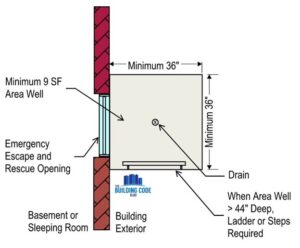I recently posted an article on the rules behind egress windows. I realize that knowing the rules doesn’t necessarily mean that you know the most common window sizes for each different window operation. So here are the basics and some links to the Anderson Window catalog as a guide:
Casement windows are minimally 2′-4″ wide by 3′-4″ high. For many casement windows you’ll need to order egress hardware which allows the window to not only swing open, but also swing away. Also remember that the sill can’t be more than 44″ above the floor so you may end up with a taller window for a head height over 6′-8″. Anderson’s Casement Sizes
Single or double hung windows are minimally 3′-0″ wide by 4′-8″ high or 2′-8″ wide and 5′-6″ high. I’ve seen a 2′-6″ wide by 5′-0″ high egress window but not all manufacturers make this window size. Anderson’s Double Hung Sizes
Slider windows are minimally 4′-0″ by 4′-0″. Again, watch the maximum sill height. Anderson’s Glider Sizes
I’ve included the links to the Anderson catalogs because they are very clear which of their windows allow for egress. Many manufacturers will call this out in their size charts. I’d suggest checking the specific sizes with the manufacturer that you intend to use and always specify which windows are intended for egress.









3 thoughts on “Common Egress Window Sizes and Operation”
Casey, I guess that depends if you’re talking about a new construction situation or a remodel.
In new construction you can put it anywhere, it just has to be designed appropriately by your architect or structural engineer.
If it is a remodel, then there are several other questions:
You said block, so I’m assuming it is a concrete block wall that you want to put it in. If so, you’ll need a header over the opening to support the newly unsupported block. It would certainly be easier if the opening was at least a couple feet from the corner but again, it can be engineered. If it is concrete and there is substantial concrete above the window, there is a chance that it may not need a header.
Another possibility if the window is close to the ceiling is that you could cut a U-shaped opening and frame a wood wall into the opening including a wood header.
The other big question is if it a bearing wall. Can you tell, do the floor joists rest on the wall or run parallel?
Obviously this advice is all sight unseen, so feel free to email me a picture or two or give me a call for more advice.
Does it matter where you decided to put a basement egress window? Someone told us that you shouldn’t put them near the corner of a basement. I didn’t know if that had something to do with ensuring the stability of the block wall…or if it’s just a myth?
Pingback: Egress Windows and Emergency Escape « EVstudio Architecture, Planning & Design | Blog | Denver & Evergreen Colorado Architect
Comments are closed.